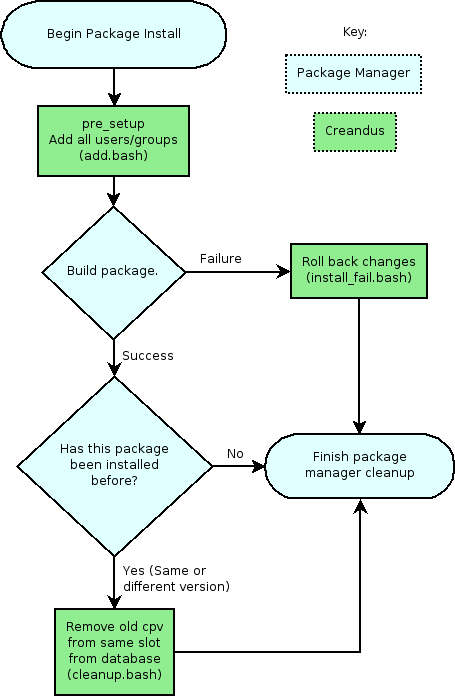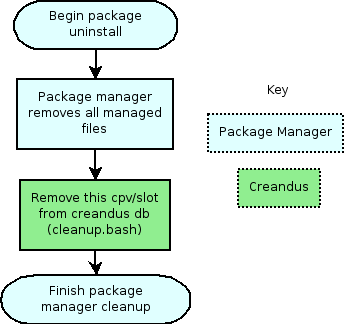Creandus API
| Author: | Mike Kelly <pioto@pioto.org> |
|---|---|
| Date: | 2007-12-25 |
| Revision: | 228 |
| Version: | 0.6.0 |
Outline
This is a sketch of the basic API for interfacing with the creandus scripts.
There are several different tasks which these scripts must do:
- Maintain a database of users and groups that have been added by the scripts.
- Add any users or groups requested by a new package to the system. At the same time, the database should be updated.
- Revert any changes made if an install fails. This is done by calling install_fail.bash with the same arguments as add.bash. It will know what needs to be done to clean up from itself (e.g. roll back the database, remove any unnecessary users or groups, etc).
- Clean up the database / etc when a package is uninstalled or up/down-graded (cleanup.bash).
- Display information about the managed users and groups, including which ones may be safely removed, and offer the operator a way to remove them elegantly (meaning cleaning up the database as well as removing them from the system). This is handled by the users.eselect script.
Public API (For Package Managers)
Adding Users and Groups
This action is performed by the add.bash script. It should be run once, before the package is unpacked, compiled, or installed. It is invoked as follows:
add.bash "new users" "new groups" cpv userspace [root]
The arguments it takes are:
- "new users"
- A single parameter, a space-separated list of new users to be added for this package.
- "new groups"
- Same as above, only for groups.
- cpv
- A unique identifier for the package about to be installed (category, name, and version).
- userspace
- A unique identifier of the userspace we are running in. This is something of the form USERLAND-ELIBC. For example, most GNU/Linux systems would specify GNU-glibc, while FreeBSD-based systems would use BSD-FreeBSD.
- [root]
- An optional parameter, defines the system root to install into. If not provided, assumes /.
Cleanup
Cleaning up from an install can be done in two different cases.
- The install failed. In this case, we call install_fail.bash with the same arguments as add.bash (described above).
- The install succeeded, but there was a previously existing version of the package (in the same SLOT, on Gentoo). Or, the package was uninstalled. In either case, we call cleanup.bash with the same arguments as add.bash (described above).
Non-Public API (Internal Use Only)
Database
These databases contain a newline separated list of package identifiers (name and version, usually), which mainly serves to tell the scripts when a user is no longer used by any package on the system. Database actions should all go through the db.bash script.
This can be invoked in 2 different modes, to add and remove an entry from the database:
db.bash add dbtype cpv newname userspace [root] db.bash del cpv [root]
The arguments are:
- dbtype
- The database to be affected (either "user" or "group").
- cpv
- A unique package identifier (category, name, and version).
- newname
- The name of the user or group to be added.
- userspace
- A unique specifier for the userspace being run under, of the form of USERLAND-ELIBC. For GNU/Linux, for example, this would be GNU-glibc; for FreeBSD, BSD-FreeBSD.
- [root]
- An optional parameter. Defines the system root to install into. If not provided, it is assumed to be /.

